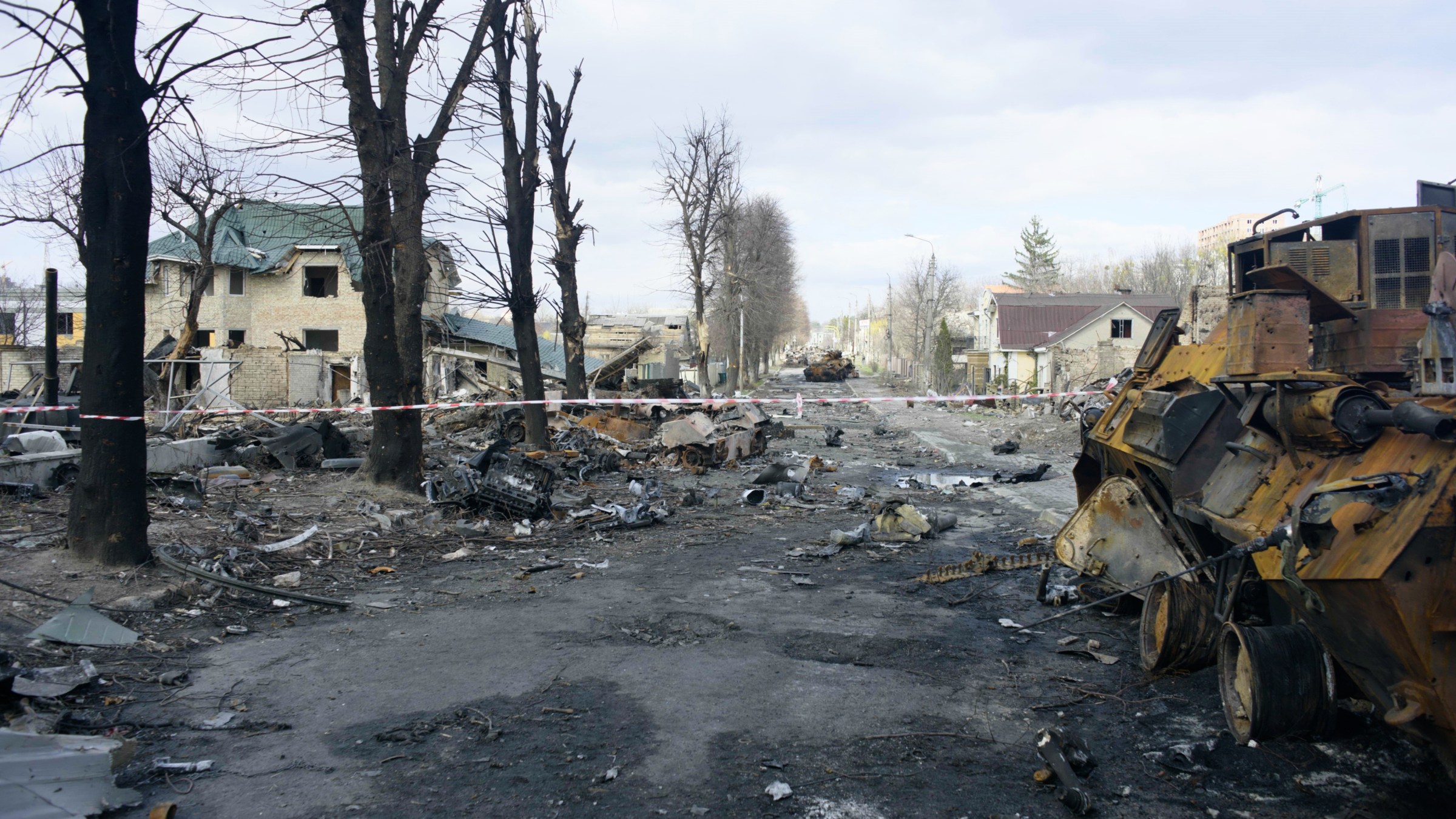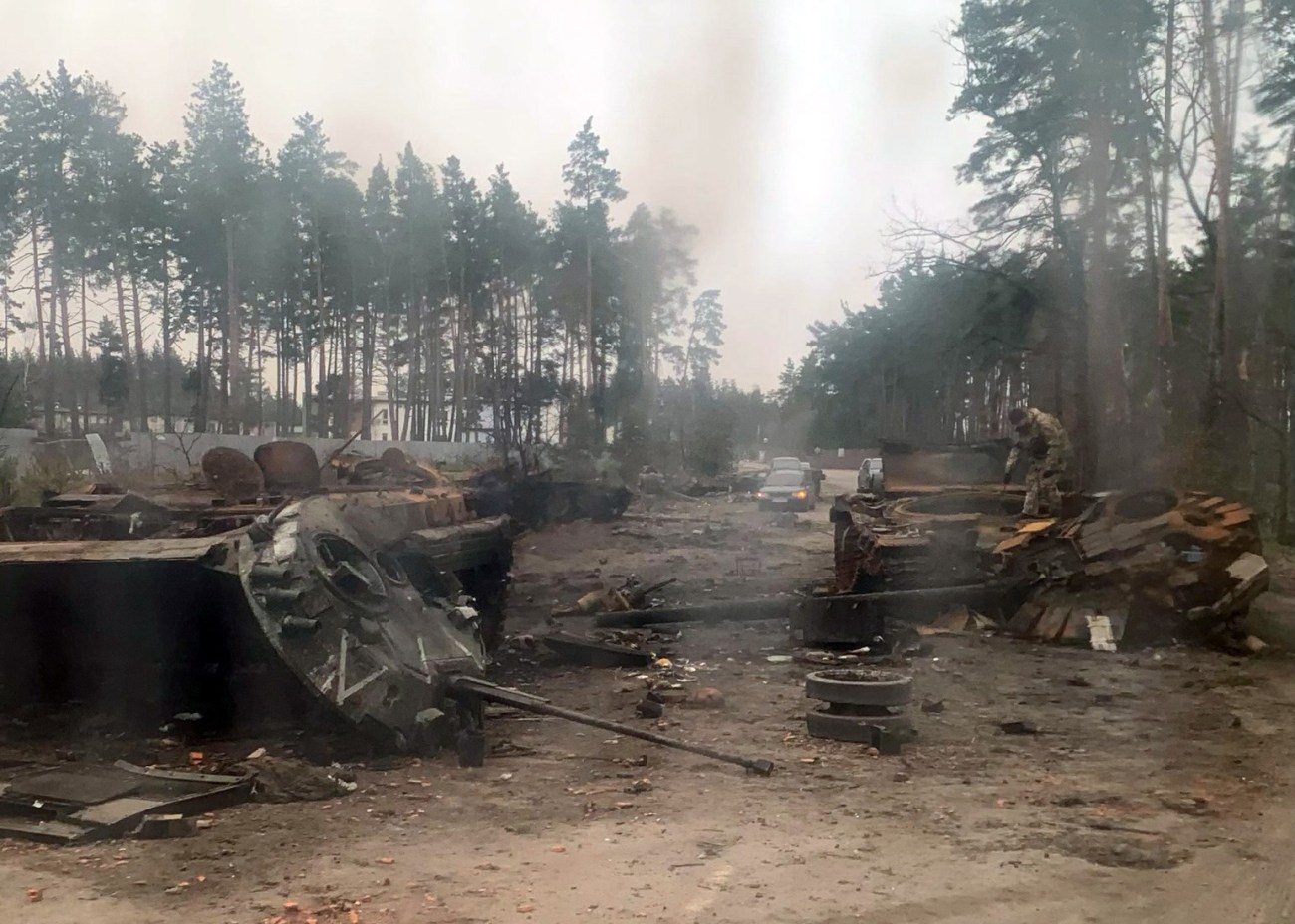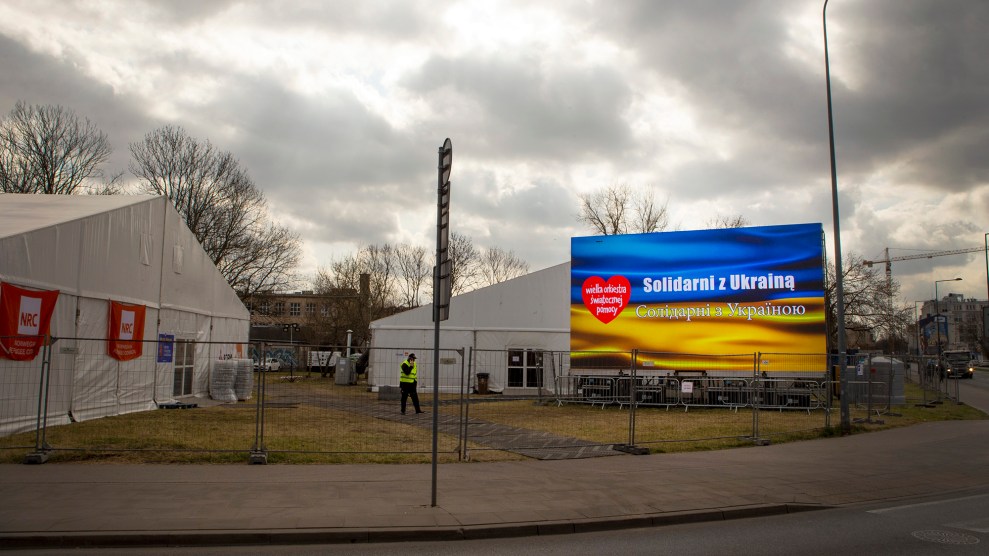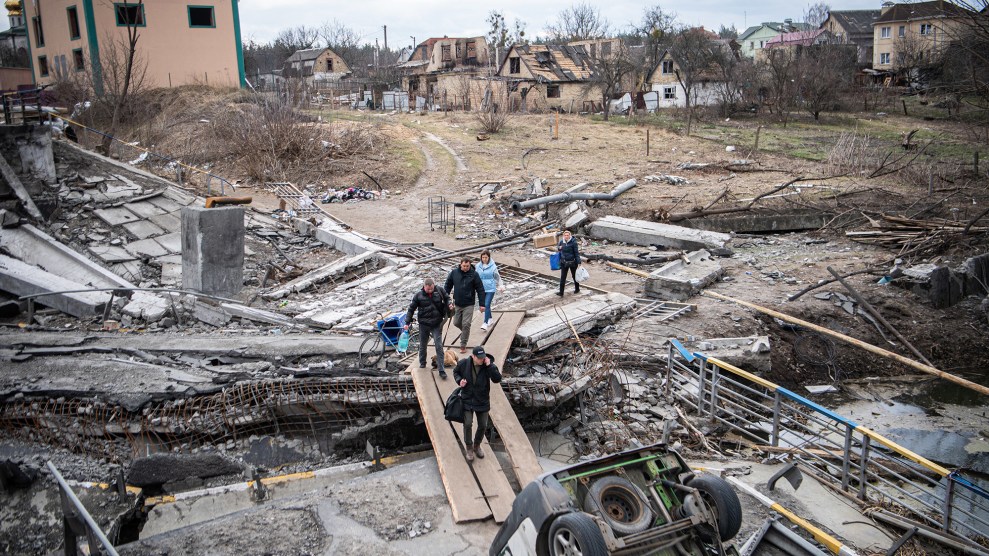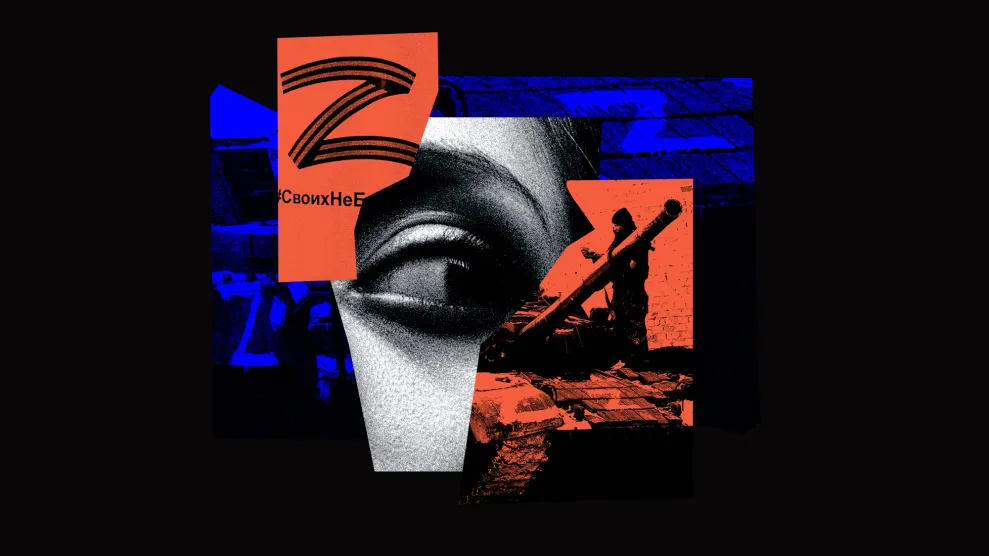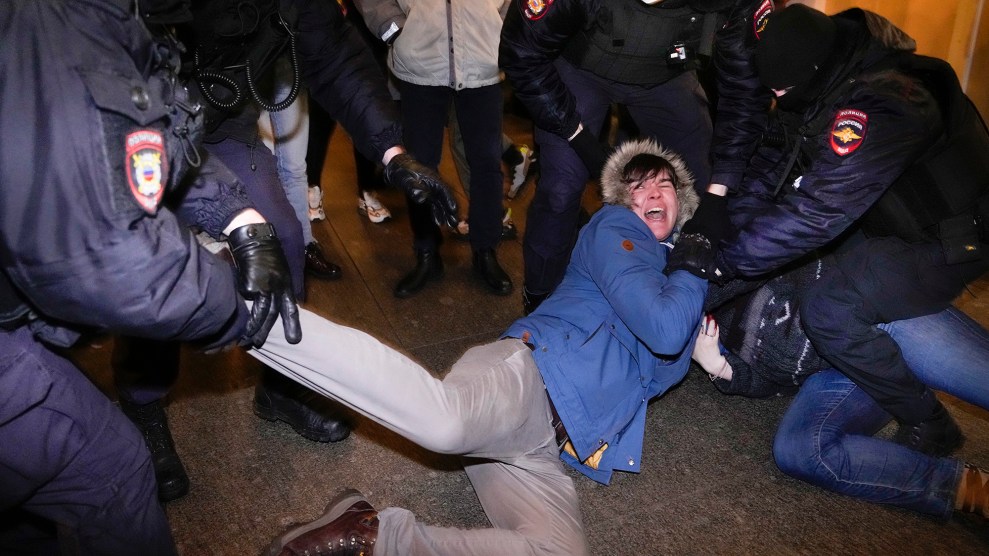Bucha was known as Ukraine’s Switzerland. Now it is synonymous with unimaginable horror.
I first traveled to the town five years ago to film a documentary about the country’s struggle to build a democracy enshrined in human rights after the 2013–2014 Maidan revolution swept a Russian proxy from the presidency. My protagonist had fled war in the embattled east to rebuild her life in Bucha, a comfortable commuter exurb on the northwest perimeter of the capital, Kyiv. With its coffeehouses, organic cheese stores, and villas adjoining leafy parks, Bucha reminded me of the neighborhood where I grew up in Sydney, Australia.
When I returned recently, it was torn to pieces, the contents of plush homes splayed on sidewalks. There were survivors on nearly every corner, waiting to tell me something that would haunt me for weeks.
Bucha is normally less than an hour from Kyiv. Now, my journey took nearly three, past checkpoints, wrecked tanks, and shot-up civilian cars, some with signs on them reading “children” and bullet holes where a driver once sat. In town, body parts still littered the streets a week after the Ukrainian army liberated its remaining residents, as I joined a macabre, government-organized tour of atrocities for mobs of reporters; I watched as several journalists took selfies with a boot containing a severed foot, rumored to be booby-trapped. “In Bucha,” an American journalist said into his mobile phone’s camera, “life is cheap.”
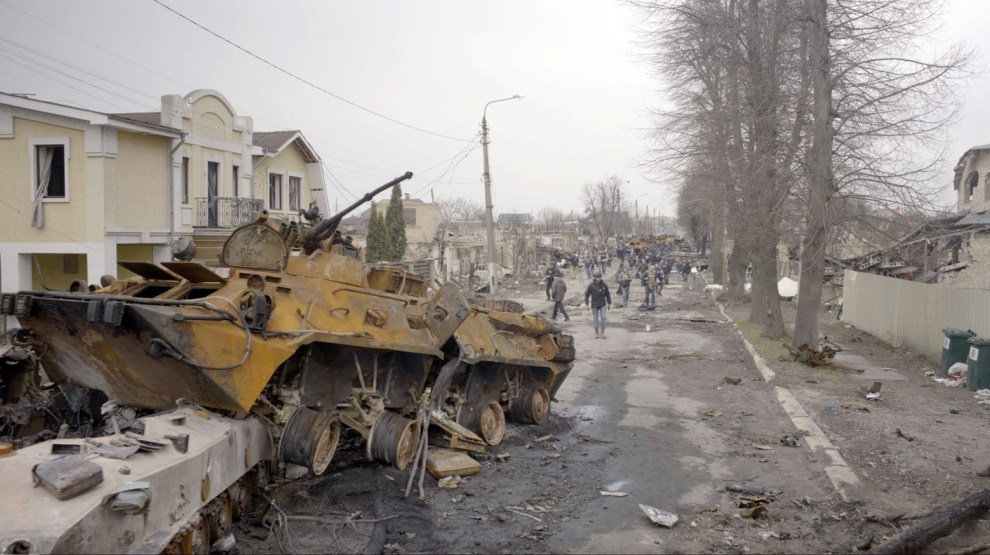
Destroyed tanks piled up in a main street of Bucha.
Anton Yaremchuk
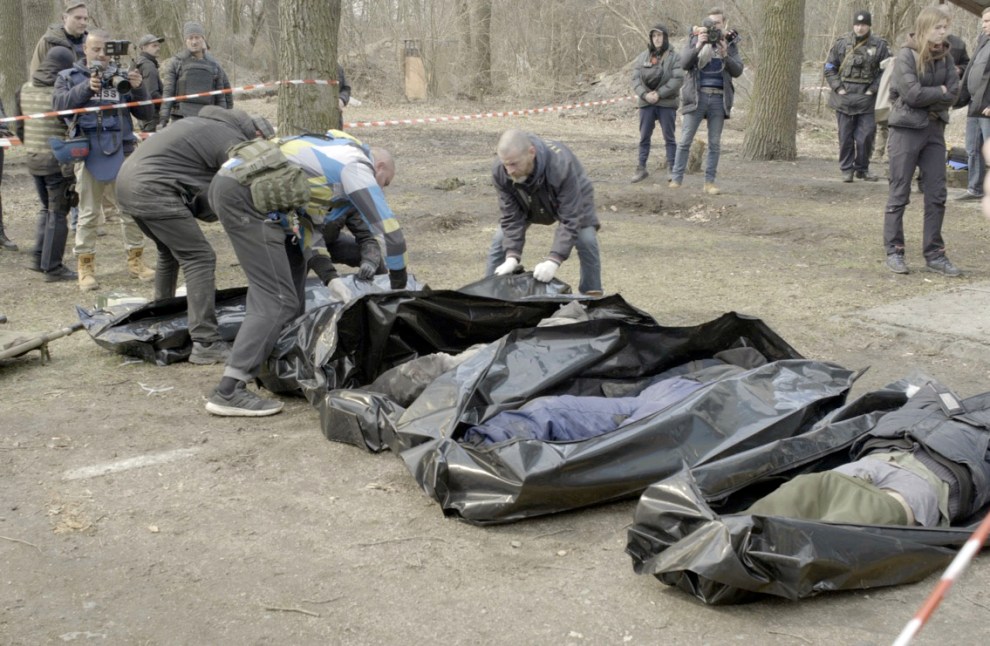
Ukrainian officials work to seal body bags as journalists look on, during an early-April press tour of Bucha’s atrocities.
Anton Yaremchuk
In a nearby forest, investigators bagged bodies of a family they say had been executed and subsequently set alight. Large parts of the downtown looked like a California-style wildfire had just raced through. I saw multiple scenes of evident mass killings, some virtually next to one another, in the back lanes. Five years earlier, I had filmed at a language high school nearby. Now, one of the teachers told me there was a rocket lodged in the playground, and two of her teenaged students were shot to death while attempting to flee in their family car.
I returned to Bucha several more times over the last month, as the town’s corpses were removed; the flocks of international journalists had largely moved on to other atrocities elsewhere in the country. An atmosphere of traumatized normality reigned. Survivors I spoke with recounted the claustrophobic fear that gripped them for nearly a month as they hid, still haunted by random associations: the thuds of explosions; the whirring tanks careening past their hiding places; the hunger in their stomachs. And then there were the endless stories of loss.
On one trip, I set off down Yablunska Street in a mainly residential area on the edge of the suburb. Many of its cottages, large and small, were now gashed or broken. As I approached downtown, I stopped at one of several multistory apartment blocks dating back to the 1970s—Brezhnevkas, they’re called, named after the Soviet leader of that era—where I met a sixty-something nurse, Zina Parasilna, who was preparing for an urgent phone conversation. First, though, she had to collect her mobile phone.
I followed her as she walked to a kindergarten where a generator whirred night and day to help locals charge their devices.
It took me a moment to piece together the choppy, one-sided Ukrainian: Zina was trying to help an acquaintance, her neighbor, collect her son’s body from the local morgue. Their conversation was plagued by numerous dropouts. “Sveta! Can you hear me?” Zina asked. “It’ll only happen on Friday.” She was talking about the paperwork required to release the body of Sveta’s son. It was only Wednesday. Sveta had fled to western Ukraine during the occupation and desperately wanted to return home to the country’s north to bury her son.
Zina was the one to find Sveta’s son’s body in his family’s home. “When our [soldiers] arrived, they told me not to touch him,” she told me. “His hands were tied. His passport lay upside down next to his head.” Zina could not say how he died.
And he wasn’t the only body she discovered when she finally emerged from her makeshift underground shelter after the fighting finally ceased.
As we stopped to talk at the site of a particularly notorious Russian checkpoint, Zina pointed to her left, to her right, and in front of her. “There was one body here, and another there, and there.”
“They just lay here, like dogs.”
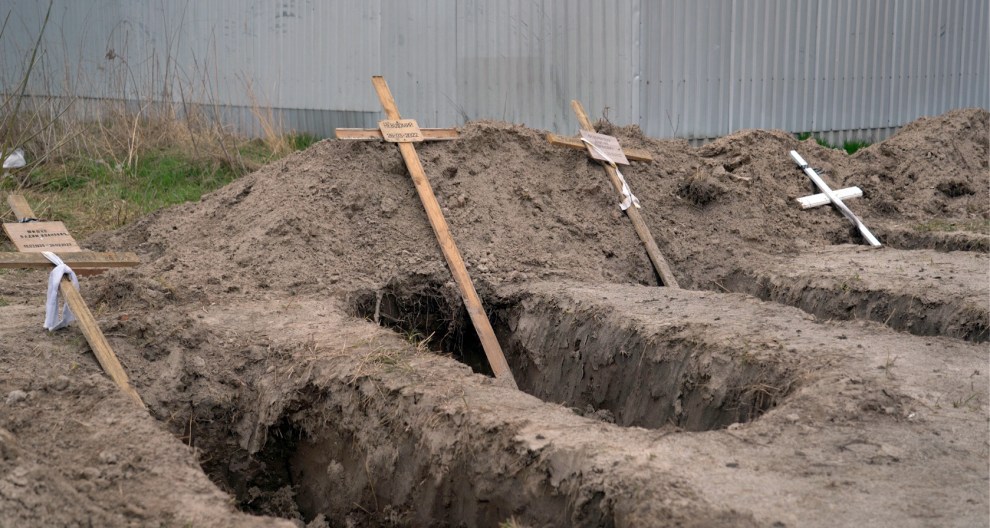
Freshly dug graves in Bucha.
Liza Pirozhkova
Zina’s story isn’t unique to Bucha. Cities like Chernihiv and Sumy, and towns like Brovary and Borodyanka, are not as well known outside Ukraine, but each was the scene of similar Russian atrocities. And while Bucha and its surroundings have become symbols of human cruelty—drawing comparisons to Srebrenica during the Bosnian War—the horrors here hint at even more profound devastation elsewhere, still out of sight to much of the world, in contested or occupied parts of the country, like Kherson and Izyum and Mariupol. A new Associated Press investigation into the March 16 Russian airstrike on a Mariupol theater found evidence that about 600 people were killed—double the previously cited toll.
Should these places ever be liberated, and sunlight shone on Russia’s reported detention and “filtration camps,” Ukrainians predict they’ll discover even greater monstrosities. When I spoke to the deputy mayor of Mariupol, Maksym Borodin, in early April, he told me he feared the revelations of how the Russian army was treating Ukrainians as it “filtered” entire neighborhoods at a camp east of the city, checking for past military service and political beliefs. Afterward, he said, those who “passed” were resettled in Russia, either voluntarily or by force. He feared that those who “failed” were disappeared or murdered.
“Look at what happened in Bucha,” he warned.

A massive Russian invasion of Ukraine began on February 24, 2022, just over eight years to the day that Putin’s ally Viktor Yanukovych fled Kyiv during the popular revolution. That day, Bucha’s residents awoke to the unfamiliar: explosions. The 2014 war in the country’s east was hundreds of miles away, and largely out of mind. Some refugees had fled the conflict in the Donbas to take shelter here, and memorials had sprung up to those who were killed in the struggle, which became mired in a stalemate. But few expected Russia to bring the war to their home that late winter morning.
Some of Russia’s best forces were sent in from its ally Belarus. A large column crossed the border near the Chernobyl nuclear reactor. At the same time, paratroopers landed at Hostomel Airbase, in the suburb next to Bucha.
Ukraine, which had reportedly received advance knowledge of Russian plans from Washington, began a frantic defense, even blowing up the airbase’s runway as it tried to delay the Russian deployment. Nonetheless, the Russians were eventually able to take control of the base, which in turn enabled the southward advance of their forces toward Bucha.
It had a population of around 40,000 before the war. It’s difficult to estimate how many have fled during the fighting. Those who remained say the Russian soldiers entered with heads full of propaganda—prejudices that even close contact with the townspeople could not dispel. They expected to find Nazis: State television had assured them they were everywhere in Ukraine. Instead, they found a bewildered but fierce opposition.
What survivors told me they experienced was a catastrophic combination of chaos and impunity. As residents sheltered in basements, Russians moved from apartment to apartment. Survival became a matter of chance, particularly for men of military age.
Russian soldiers trashed the downtown luxury apartment block where Nikolai Miselevich, a middle-aged former soldier who had become a prosperous builder, lives. The place looked as if an intoxicated ’60s rock band had been put in charge of a military occupation. “A soldier would spot a plasma television and he’d take off with it. Then the next soldier would break in next door—and he’d spot a plasma TV, too,” Nikolai told me. “They’d fill up all the toilet bowls until they overflowed. After one was full, they’d go to the next one and then shit everywhere.” I saw clothes and personal documents, including a Russian passport, laying all over the floor. Other apartment doors could not be opened for fear they were still rigged with mines.
“When the commander and his men got drunk, things were the worst,” he said, holding back tears. “They tortured a guy to death.”
“At least my mother was safe. She’s small and elderly, a widow,” he continued. “A lot of the younger girls—they were raped.”
By March 5, the Russian army and the Rosgvardia, the paramilitary-style National Guard force, had fully occupied Bucha. The units there included the 64th motor rifle brigade, from Khabarovsk in Russia’s Far East, and the 104 Air Assault Division, normally based near Russia’s border with Estonia on the edge of the European Union. Later, in mid-April, President Putin issued a decree honoring the 64th for “outstanding heroism.”
But on the ground, Russian soldiers grew more and more frightened as it became clear that this would not be a quick and easy victory. On the other side of a small strip of forest, they had failed to take full control of the neighboring suburb of Irpin, and Ukrainian civil defense militias attacked their checkpoints with Molotov cocktails. Bucha residents used a government app on their cellphones to share information about the Russian positions.
Around mid-March, the Russian army opened a “green corridor” for residents to leave. But Aleksandr Konovalo, a designer who knew Zina, the nurse I’d met earlier, told me many more people were shot and killed “en masse” before the evacuations began. “When people found out that the corridor was opening they just fled to Irpin, where there were buses to take them on,” he said. “After that they began to push people down into the basements and shoot them. They told us that was their task.”
Aleksandr led me to a yard near his block, past residents making tea over an open fire—electricity remained cut off. He pointed to a spot, past another shot-up car, where the earth was recently dug. It is the shallow grave of his cousin, Dima.
“Dima had gone outside the bomb shelter to smoke,” Aleksandr told me. “A Russian soldier walked up to him and just shot him. He checked his pulse afterward and then kept walking.”
“His body lay there outside the shelter for three days,” he went on. “It was full of people, but they didn’t want to touch him because armed Russian soldiers and tanks were constantly going past.”
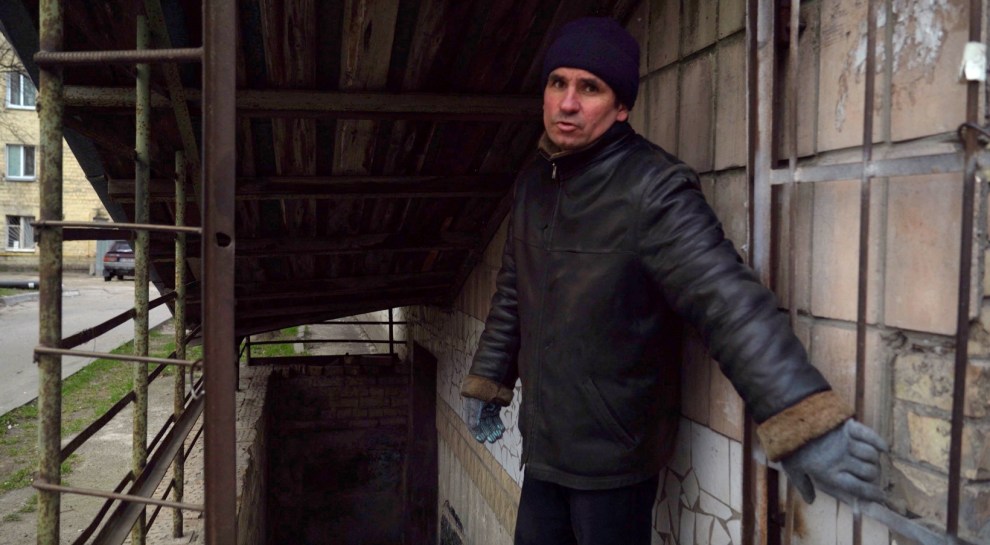
Aleksandr at the bomb shelter where his cousin Dima was killed.
Liza Pirozhkova
Later, as Aleksandr and his brother shoveled dirt over Dima’s body, a Russian soldier looked on. I wondered if the soldier expressed any remorse for what his comrade had done.
“He offered to let us go to Russia,” Aleksandr said, with a mixture of bemusement and contempt. “I wanted to shout at him. Because Russia is like a jail for me. But I just said no, because he had a gun.”
Another resident, Sasha Lubaretz, a salesperson, recounted yet more horrors. On March 24, he said, Russians dropped what he believed was a white phosphorus bomb near a soccer field. “It burnt for two nights and two days,” Sasha told me in a text message. “The cloud was there in the morning and it was there at night.” It is illegal to use phosphorus bombs in civilian areas because they are highly incendiary and are capable of burning through both skin and bone. He sent me photos of the bright orange night sky after the explosion. His account matches images captured by Britain’s ITV, showing a blast followed by a white pattern in the sky, like a shooting star, to the northwest of Kyiv.
As the occupation ground on, the Russian soldiers felt less secure at checkpoints and began to fire on cars. They also began to kill at random, shooting people on the street or from their positions atop buildings. Other people might be spared by the good graces of the soldiers: A man who fought with the Soviets in Afghanistan was saved when his former Russian commander recognized him.
Many of the killings seemed to depend on the whims of whoever was in charge of the checkpoints, as well as what soldiers discovered on residents’ social media during spot-checks of phones. Was this a coordinated operation involving interrogations and planned executions to kill off the local elite and activists? Or were soldiers permitted to simply do whatever they pleased?
Investigators told me it’s too early to corroborate this and other stories of specific atrocities residents told me, and to determine who gave which orders to whom. They are still probing whether decision-makers in Moscow were aware of what was going on in the occupied territories outside of Kyiv.
But they believe the chain of command was still functioning. And the fact that many of the dead were found in a prone position with their hands tied indicated that at least some of the killings were executions. As of April 20, about 580 bodies had so far been found in the cellars and backyards of Bucha, according to Kyiv Region Prosecutor Maksym Krim—over 80 percent of them with gunshot wounds. Krim told me this week that more than 500 of those bodies have now been identified as civilians killed during the occupation.
A massive and daunting international effort to document the crimes is only just beginning. A team of several hundred criminal investigators are supported by technicians from French and Slovakian forensic experts, Krim told me by phone. So far they have opened more than 400 cases. The process is being supervised by International Criminal Court investigators.
Human rights groups such as Amnesty International plus the UN have already completed smaller-scale probes documenting some of the apparent war crimes in Bucha. UN High Commissioner for Human Rights Michelle Bachelet expressed horror at the images from the streets of Bucha; her investigators documented a “summary execution of some 50 civilians” during a visit to the suburb on April 9, the UN said in a statement.
Meanwhile, US President Joe Biden declared the Russian president a “war criminal.”
In response to these accusations, President Putin called Bucha “a crude and cynical provocation” by the Ukrainians.

Just around the corner from the ruined luxury apartment blocks where Nikolai lived was a preschool. All of the stores I saw in Bucha had either been trashed and looted or remained shut. Volunteers brought in aid from Kyiv, 20 miles away, which was being distributed on the school’s front steps.
Here, I met 50-year-old education professor Vladislava Lubaretz and her husband, Sasha. Vladislava said she is staying in Bucha, in part to coordinate the city’s near daily delivery of food.
We headed down to the school’s cellar, which served as her hiding place during the fighting. The air was clammy. It smelled of clay soil. There were still children’s toys and card games left out on miniature tables. And a half-clean children’s toilet.
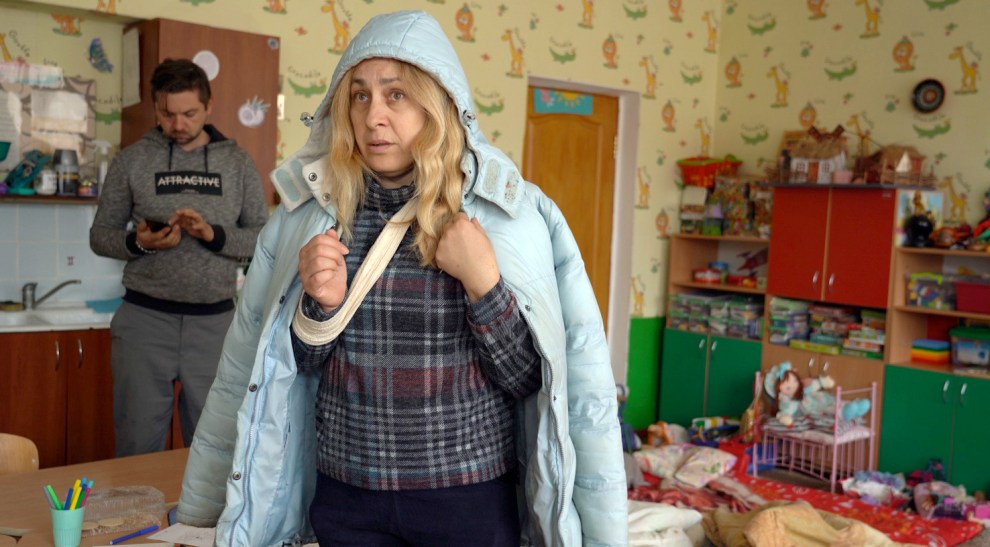
Vladislava Lubaretz and her husband, Sasha, at a Bucha kindergarten. They hid in its basement for a month.
Liza Pirozhkova
During the bombing, Vladislava told me, she would hold her daughter and her son tight to her body and stand next to the wall. “I would pray every five minutes,” she said. “I taught the children that an angel was watching over us and protecting us. And that’s how we survived.”
For the family, the worst moment in the occupation came as fighting intensified, and Ukrainian troops began to take control of larger areas of neighboring Irpin—bordering their part of Bucha. That was when Russian forces deployed the heaviest ammunition at their disposal, they told me. Then, by the end of March, overstretched by a front thousands of miles long, the Russians began to retreat.
Dazed and overwhelmed, locals began to reemerge from the basements.
“No one was shooting anymore. Nothing was exploding. Tanks weren’t driving back and forth,” Vladislava told me, as we walked past a pulverized shopping center. “There was complete quiet.”
“I had the feeling that we were the only survivors,” she said. “That they had dropped a huge bomb and everyone else had died.”
Over days in mid-April, as I talked to the survivors of Bucha, residents slowly started to return to the town. The unlucky ones, like Zina’s neighbor, were there to collect the dead. Those with more luck were there to collect their remaining possessions, only to leave again—either to Kyiv or the relatively secure west of the country, or further afield, to Poland or Germany.
Some, like Zina, were unable to return to their homes, which are still booby-trapped. They continued to spend their nights in Bucha’s bomb shelters and preschools.
Many of those who remained throughout the occupation remained determined to stay and rebuild. Either literally, in the case of builder Nikolai, or metaphorically, like Vladislava and her family, who hoped to help the old and the infirm, now the majority of residents.
“Bucha used to be such a young town,” Vladislava said, sobbing. “Young families lived here. It was such a sunny place. Everyone in Kyiv wanted to live here. There were so many serene green parks. And it was full of good people.”
Others remain in Bucha because they are animated by a desire for justice. Aleksandr, who buried his cousin, is putting energy into collecting the personal effects left strewn on the streets of the suburb by the retreating Russians.
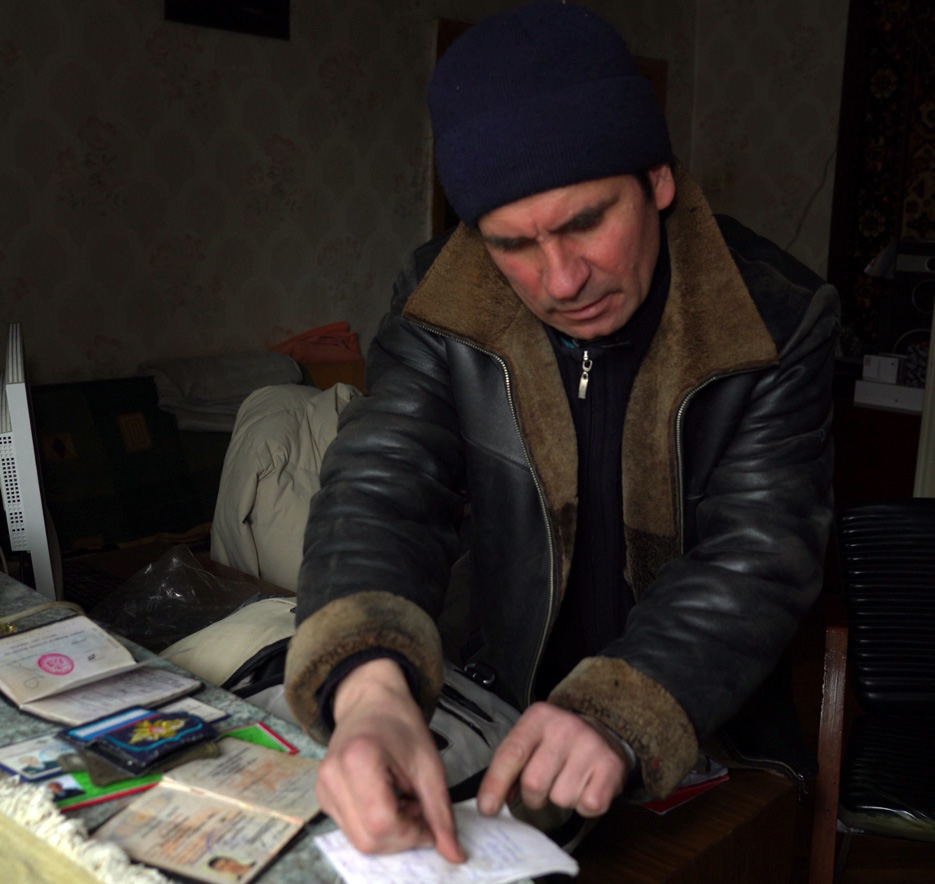
Aleksandr pores over a trove of personal effects he discovered in Bucha’s rubble.
Liza Pirozhkova
He found them in the rubble on Vokzalna Street after the Ukrainians ambushed a Russian column comprising dozens of tanks. He briefly left the room and reemerged with the possessions, which he had neatly packed into plastic sleeves. His collection includes passports, ancient portable phone battery packs with soldiers’ names on them—and a mobile phone he found next to a busted tank in Vokzalna Street.
On it is a video that shows a Russian soldier pushing his daughter on a swing. They’re in a children’s playground in front of a Brezhnevka. That apartment block looks very much like Aleksandr’s in Ukraine. The toddler—clad in a hot pink jacket—says a few words, then she giggles.
“The view looks like the one out my window,” Aleksandr says. “The nature is just the same as here. They are just ordinary people. How could he come to Ukraine and commit murder?”
Oleksandr Portian, Liza Pirozhkova, and Anton Yaremchuk assisted with reporting.
